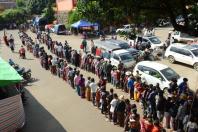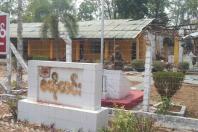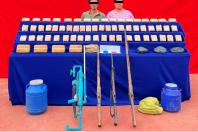SINGAPORE - Hundreds of excited onlookers cheered in Jurong as the Moon moved into position to obscure the Sun at 1.24pm on Thursday (Dec 26) and form a “ring of fire”, in what has been dubbed the “greatest astronomical event in Singapore”.
They were among the thousands at the Science Centre and elsewhere across the island, from Ang Mo Kio to the Marina Barrage, who turned their eyes to the sky to catch the annular solar eclipse.
Many turned up with their young children and elderly parents, with several bringing along mats, stools and umbrellas for the wait under the warm Sun before the eclipse began at about 11.30am. The phenomenon was expected to last until 3.18am.
More serious enthusiasts came armed with telescopes on tripod stands to photograph the historic moment.
“It’s much better when you see it with your own eyes, instead of on television or in photos,” said Ms Nurul Huda, 27, who was at the Science Centre to attend her first astronomy event.
An annular solar eclipse occurs when the Moon covers the centre of the Sun, giving the appearance of a fiery ring around it.
The rare astronomical sight was visible in the Singapore sky on Thursday for the first time in two decades, and will next appear in 2063.
Many like Ms Huda were not sure if they would still be alive by the time the eclipse returns about 40 years later.
“If I’m not, this will be the first and last time I’m seeing this – it is indeed a once-in-a-lifetime experience for me,” said Ms Huda, who is in between jobs.
About 6,000 solar viewing glasses were prepared at the Science Centre for a viewing event, and by 1.15pm, the glasses were all sold out. People began queuing for the glasses at about 9am to catch the eclipse, which started around 11.30am. The eclipse is expected to last until 3.18pm.
At National Junior College (NJC) in Bukit Timah, more than 1,000 people assembled to catch the rare astronomical phenomenon at the school.
NJC set up 14 high-powered telescopes in the school field for members of the public - who started streaming in at about 9am - to view the eclipse. The school is home to the largest and highest resolution amateur-class solar telescopes here.
Polytechnic senior lecturer Edwin Tan, 43, was one of many at NJC to catch the eclipse with his family. He said he was excited that “it would be totally dark for one or two minutes” during the astronomical event.
Dr Kunwar Bir Singh, who was with his 13-year-old daughter and her friend, said he saw an eclipse when he was very young but Thursday’s phenomenon was the first time he got to see an annular solar eclipse properly through a telescope.
“It’s a new experience, a once-in-a-lifetime thing that you won’t see every day,” said Dr Singh, 43.
For others like Mrs Ophelia See, a 40-year-old housewife who was with her two daughters aged two and seven, the event was "a good opportunity for (my children) to learn about science".
Mr Alfred Tan, 59, vice-principal of administration at NJC and a solar astronomer with 10 years of experience, noted that the next annular eclipse will happen 44 years later.
"To see it, I will have to live above a hundred years old, and that eclipse will not be as spectacular," said Mr Tan.
His school’s eclipse viewing event was organised with the help of 44 student volunteers from NJC’s basketball club.
Mr Tan and the volunteers stayed overnight in the school to help prepare for the event, with the principal working through the night to adjust and set up the telescopes.
Readers can share their photos of the eclipse with The Straits Times by using #sgeclipse when posting them on Instagram.
















